SS Normandie: Art Deco Elegance and Innovation on the High Seas (1937)
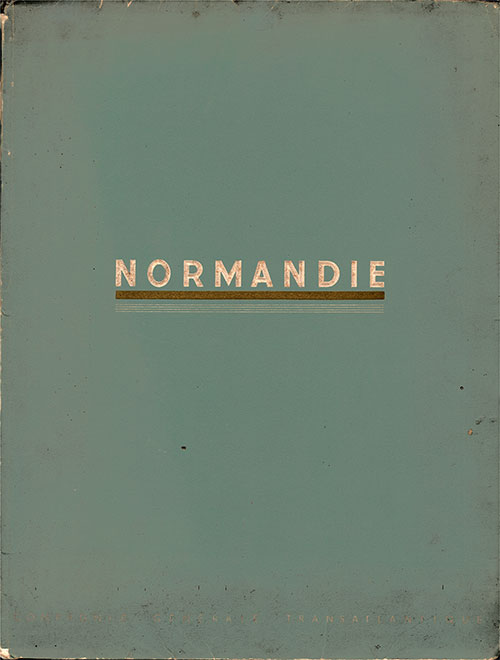
Cover of the 1937 “Normandie” booklet from the Compagnie Générale Transatlantique – French Line. | GGA Image ID # 12735ac62a
The 72-page booklet details the incredible luxury aboard the Normandie liner - the pride and joy of living of Compagnie Générale Transatlantique - French Line. Printed in France in 1937, it has become a highly sought after item by collectors.
Explore the 1937 SS Normandie through the French Line's detailed brochure. Discover Art Deco design, maritime innovation, and luxurious transatlantic travel. Ideal for historians, educators, and maritime enthusiasts.
Introduction to the Visit to “Normandy”
“BUT where is the boat?... I want to see the boat”, cried a little boy amazed by the winter garden, the games room, the swimming pool, the library, the halls, the immense lounges that he was shown around in turn.
This charming word sums up the paradox constituted by these floating cities where everything is combined to make the passenger believe that he has not left his element, that he lives in the middle of the same certainties, the same birds, the same flowers, in a sort of earthly paradise where all his desires are fulfilled.
“NORMANDY” constitutes, in this respect, an incomparable tour de force. Never before had we shown such ardor to construct a beautiful dream, to complete such a living abstraction, such generosity to dazzle.
The first of these generosity was that of space. Space, so measured, usually, on these closed worlds, these floating prisons where everything, even the gesture, seems to have to be economized, space, here, is the most improbable of riches.
For the first time the length and capacity of the vessel allowed the architect to play with proportions that seemed forbidden to sea monsters.
It is above all for the nobility of these proportions that “NORMANDY” deserves to be admired. Here the first of the artists – we forget it too much – is the engineer.
He is the one who designed the vital organs of the ship as well as its external structure and allowed this beautiful steed to overcome all resistance, to beat all records.
Perhaps the maximum amount of aesthetic emotion is found in the rooms of the engines, boilers, turbo-alternators, at the invisible center of the action, where the propulsive forces meet. Here naked logic, the elimination of all parasitic ornament are enough to create the sublime.
If the successive embellishments made by the decorator have an immediate reward, thanks to the permanent contact they have with the passenger, it is appropriate to give thanks above all to the architect, to the architects responsible for distributing the space to best meet the requirements of the body and mind.
Let's forget for a moment the riches with which we adorned the walls: let's imagine them in their nudity and remember the technical problems that had to be solved so that, in a universe that is unstable by definition, matter can resist pressure and variations. the most diverse, and so that finally grace always remains in the service of force.
Such a liner, by the importance he attached to places of reception, to places where we communicate - in prayer, in reading, in dramatic work as in the pleasures of the table or sport — shows that it was imagined in an eminently sociable era for which a crossing is a collective emotion and I would almost say a celebration.
“NORMANDIE” also met the requirements of easy production time and feverish exchanges. He is a child of the golden age, which is enough to explain why gold was poured in abundance, as a symbol, on the coverings, the bas-reliefs, the statues, that we preferred marble, onyx and the rarest materials.
While this palace was being completed, terrible tremors tore the old world apart: gold disappeared from its sky. This is why “NORMANDIE”, commissioned in 1935, is already, despite its youth, a witness.
It retains, in these dark hours, a triumphant appearance, the grand airs both intimate and sumptuous for which it would be wrong to criticize it because they respond to the very desires of those for whom it was designed. Messenger of French quality, as Mr. Henri CANGARDEL so well said, a link between America and France, “NORMANDIE” is especially intended for a foreign clientele for whom relationship life is essential. and which values the superfluous almost as much as the necessary.
This is how those who presided over the final choice of decorators and the choice of materials took into account both their preferences and those they gave to their passengers.
A liner is not a museum, nor even a palace: it is an instrument of transport as well as a hotel. Safety, comfort, these are its primary virtues. Then comes the art of entertaining, of adorning time in a charming way.
It was therefore much less a question, in the decorative field, of appealing to absolute beauties than to the fantasy of the present. A great competition was established between the designers who, for twenty years, have set out to beautify our homes, to bring light of all kinds into them, to chase away any anachronism.
They were invited to use new materials adapted to new requirements. Prudence and the taste of the day requiring large surfaces without hangings and without ornaments, they were allowed to correct, thanks to the brilliance of the coverings, what such a design could have been too austere.
Painters and sculptors capable of complying with particular requirements acted as illustrators. Among all these innovations there are undoubtedly some that are questionable, but doesn't their very diversity contribute to giving a fairly complete picture of what the preferences of an era were?
It is only too true that France, for a hundred years, has been in pursuit of a style. We are still in the process of groping: the 1925 exhibition proved it. It was therefore a great act of courage to address a hundred researchers rather than sticking to old certainties and parodying the past.
We will be grateful to the Compagnie Transatlantique for having made available to a team of painters and sculptors who asked in vain for walls, vast surfaces so that they can realize for themselves and what they know and what they still have to learn.
The “NORMANDY” experience precedes that of 1937. It encountered the same difficulties. But this experience has its nobility.
Instead of quibbling over a particular detail, let us admire here the artistic and technical achievements that were daring, particularly in the field of lighting. How can we not applaud indisputable successes, such as those of the ironworkers and the multiple approvals that the liner owes to the use of the most varied covering materials: precious species, glass, marble, lacquer, enamels, leathers, etc...
Once again, let’s not get hypnotized by the most sumptuous parts of “NORMANDY”. It is to the usual parts that we must return, to the cabins themselves (in the arrangement of which our decorators really competed in taste and fantasy, multiplying variations on a similar theme), to the passageways, to the reception desks, to the corbelled bridges, terraces, and — how could we forget them? — in the kitchens; to everything that satisfies us so fully through the economy of means, the perfection of the responses provided to specific problems. The simpler this answer is, the more merit it often has.
It could well be that we will discover as many successful solutions in the layout of the “Tourists” or in the premises of the “third” classes as in the first classes.
Which would prove that, even on a luxury liner like this, everyone is entitled to their share of beauty, and that beauty is not, necessarily, proportional to the expense...
Claude ROGER-MARX.
The Design of the Liner “Normandie”

The Design of the Liner “Normandie.” GGA Image ID # 1265641a25
The problem to be solved was the following: to build a ship fast enough to ensure a fortnightly departure from Le Havre to New York, whereas previously two liners were needed to maintain this pace.
In order to achieve this, the speed to be achieved over the 3,000 miles which separate these two ports had to reach 28 to 29 knots, corresponding to a crossing of around a hundred hours which leaves a beat of forty-eight hours for each trip of line.
Engine, Dimensions and Hull Shapes
The choice of engine and evaporative device was first decided. To obtain the maximum power with the minimum space requirement, water tube boilers were adopted and electric propulsion was preferred to the gear turbine, the first being more flexible, quieter and having the considerable advantage over the second to be able to use all the power in reverse.
The types of engine and evaporative device having been decided, the main dimensions of the ship were determined. To be able to maintain the speed imposed by the planned schedule in all weathers, they had to be increased to 2,313 meters in length and 36 meters in width.
The calculations as well as the model tests carried out in the Paris and Hamburg basins led to the adoption of very fine hull shapes, including a bulbous bulge at the lower part of the bow.
Once the dimensions and shapes of the hull had been established, it remained to design the interior accommodations and superstructures of the ship.
The Accommodation Plan

The Accommodation Plan for the SS “Normandie.” GGA Image ID # 1265ac124e
This plan is influenced by the principle of an interior dining room for first class passengers, having the height of three between decks, but occupying, in width, only the central part of the ship, so as to accommodate between its walls and the hull the space necessary to accommodate a longitudinal passageway and a row of exterior cabins.
This solution made it possible to considerably increase the number of exterior cabins (which are preferred by the passenger) without it being necessary, as had been done until then on certain ships, to reduce their longitudinal dimensions and make them thus a kind of more or less irregular corridors which lead to a porthole, and where the furniture is placed as best it can.
Undoubtedly such a dining room is deprived of openings opening onto the outside, but this offers hardly any inconvenience if we consider that, in the bad weather which reigns for a large part of the year on the North Atlantic, these openings must be closed, and that, moreover, “air conditioning” requires the closure of the room provided with them. Moreover, the grill restaurant located on the rear terraces of the ship allows passengers who wish to take their meals in a room whose large windows overlook the sea.
Given the great length (86 meters) of this interior dining room, we were led, to facilitate service, to place the kitchen and the galley not on the same deck, but immediately below, so that the boys can use judiciously placed groups of stairs to access the central part of the room; the maximum distance they have to travel is less than if the office was on one level. To be able to carry out the necessary cutting of decks inside the ship without reducing the strength of the hull, the dining room was placed under the main deck, keeping two complete decks intact above it: the main deck and the promenade bridge.
Both because of the location chosen for this vast room and to avoid breaking the majestic perspective of the other large common premises (theater, hall, large lounge, smoking room, grill restaurant) placed in a row on the promenade deck, the ducts of smoke which usually passes through the center of the ship, have been split and only meet at the very base of the chimneys.
At the rear of the 1st class dining room and on the same level is that of the "Tourists" and, one deck lower, that of the 3rd classes, at the level of the large galley which feeds the three classes of passengers.
Tourist class and 3rd class passengers are in fact accommodated at the rear of the ship, which ensures greater comfort and provides them with discovery walks accessible at all times. The crew is accommodated at the front of the ship.
This is, in its very broad outlines, the general plan of accommodation which follows logically from the chosen starting point.
The Role of Architects in Planning. Decoration
For the general layout and the determination of the volumes and proportions of the large common premises, the Naval Architects called on Land Architects, wishing to associate them, as well as our artists, with the success of the liner.
Apart from the balanced distribution of volumes and the harmonious fixing of proportions, they helped in the use for decoration of various materials, generally non-combustible, molded and decorated glass, staff, marble, lacquer, ceramics, etc.
The decorators were asked to furnish and decorate the common premises. Moreover, for the first class cabins, these artists were able to give free rein to their talent and their fantasy in the search for variety.
Thus, for the creation of the four main types of cabins that were presented, thirty-seven projects were selected which made it possible, by also varying the wood species and the colors of the hangings for each, to eliminate uniformity and monotony that would have been tedious for so many cabins.
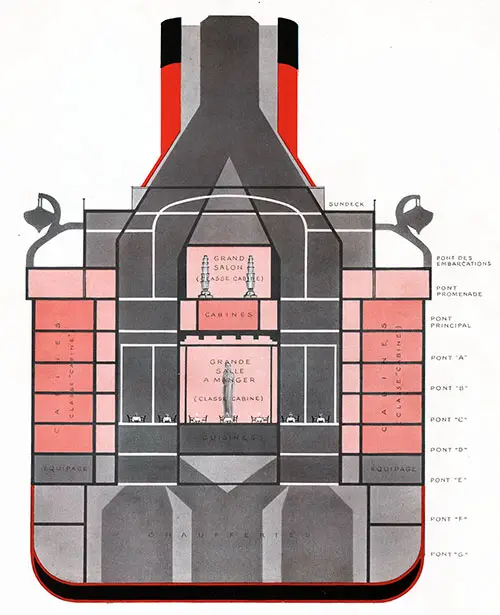
A cross section of the liner Normandie showing the decks including Promenade Deck, Main Deck, "A" to "G" and the Grande Salon (Cabin Class), as well as the Grande Salle a Manger (Cabin Class). GGA Image ID # 126623bedc
These are MM. Patout and Pacon who were particularly responsible for creating the perspective which goes from the Chapel, via the large hall, to the Cabin class dining room, as well as the swimming pool. MM. Bouwens de Boijcn and Expert created the other succession of rooms on the upper deck: theater, gallery-lounge, large lounge, smoking room, grill as well as the winter garden.
External Shapes of the Ship
What characterizes the exterior appearance of “NORMANDIE” is its curved bow, its rounded “spoon”-shaped stern, its turtle-back front beach, clear of all gear, and separated by an imposing breakwater. of the bridge which follows it, the elegant line of its upper decks which end towards the rear in a series of harmoniously tiered rounded terraces, its three robust aerodynamic chimneys of decreasing height, its thin mast nicely inclined, its open decks completely unobstructed by the total absence of windsocks and, except for the two cranes placed at the front, of loading equipment.
By a bold innovation, all the mooring and maneuvering devices were sheltered under covered decks, so that no movement of men is visible, as on other ships, during the departure or docking of the immense liner.
No more need for raincoats or raincoats: the sailors work sheltered from the rain and snow, under the command of the officer who, from his post, alone sees what is happening outside. The desire to better protect people and equipment has led to certain exterior shapes being made clearer and more elegant.
It is also practical necessities - (duplication of flues, less resistance to advancement) - combined with aesthetic concerns, which determined the shape of the chimneys, and their number too: the third, in fact, is false, but it balances the two others which, erected on the front of the ship, offer a large surface to the wind; it houses various devices and harmoniously completes the silhouette of the ship.
Happy results of the collaboration of the engineer, the architect and the marine painter.
Final Focus
The attention of the builders of “NORMANDY” was constantly applied to considerations of speed and endurance, defense against the sea, solidity, weight, stability, and passenger comfort.
The problem of tremors for which there was a lack of experience was solved, after commissioning, in a perfect manner thanks to modifications made to the ailerons, reinforcements and the substitution of four four-wing propellers for those used during the course. of the first year and which only included three.
Since this development, “NORMANDIE” is, despite its high speed, free from tremors. Her maneuvering is remarkable and her seaworthiness has proven to be excellent in heavy winter weather.
The bold design of “NORMANDIE”, a deliberately modern ship, its perfect construction and development make this liner a masterpiece of French science, technology and art.
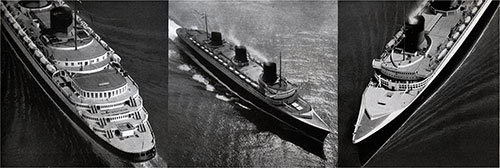
Three Views of the Liner “Normandie” at Sea. | GGA Image ID # 12667797a7
Some Dates and Some Figures
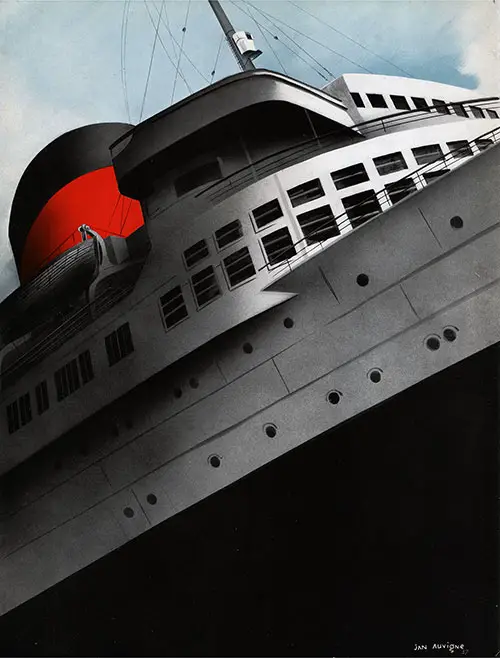
The SS Normandie by Jan Auvigne. | GGA Image ID # 1266827ef9
Started on January 26, 1931 at the PENHOET Workshops and Chantiers, “NORMANDIE” was launched on October 29, 1932.
He made his first trip from May 29 to June 12, 1935 and received a triumphant welcome in New York after having won the BLUE RIBBON for the first time.
- Tonnage (gross tonnage) 83,423 Tx
- Power 160,000 HP
- Length 313 m. 75
- Hollow 28 m.
- Width 36 m. 40
- Draft 11 m. 16
“NORMANDIE” holds, in addition to the world record for the average annual speed of crossings of the North Atlantic, the following records:
- BLUE RIBBON record 31 knots 20
- Record for the best East-West crossing 30 knots 58
- Record for the most miles traveled in
the day 781 miles - Record for the best daily average 31 knots 65
More than 3,000 people live on board “NORMANDIE”:
Passengers
- Class “Cabin” 750
- Class “Tourist” 625
- 3rd Classes 340
Total Number of Passengers 1.715
Crew
- “Bridge” Staff 13
- “Machine” Staff 27
- “Civilian” Staff 16
- “Bridge” Services 113
- “Machine” Services 252
“Civil” Services:
- Live 51
- Kitchens 136
- Dining room 194
- Reception 30
- Salons-Cabins 300
- Miscellaneous 215
Total Number of Crew 1,347
SS Normandie
Memories and Monuments of this Province having inspired the decoration of the liner, some historical notes will usefully precede your visit.
It was in the 9th century that this opulent region fell into the hands of pirates who came from Scandinavia in their longships, with their families. They settled there, fought battles and obtained from the King of France that these lands be ceded to them.
But a very French miracle took place: the conqueror was assimilated by his conquest. A peaceful population, with sedentary morals, of Belgian, Celtic or Latin origin, inhabited this region: blood mixed; the harsh, acclimatized men of the North shed their barbarity, became Christians and adopted the language of the country.
Their conquering character did not disappear, however, and further precipitated the Norman Knights into distant adventures: they founded a kingdom in Southern Italy and Sicily, conquered England, which the victory of Hastings delivered in 1066 to William the Conqueror, Duke of Normandy and King of England, participated in the Crusades and maritime expeditions.
Our sailors today proudly continue through the centuries the tradition bequeathed by their ancestors the Vikings, “the Kings of the Sea” and their heirs the adventurous discoverers.
The History of Normandy remains inscribed in its stones of a very rare quality. Because to the charm of its fertile valleys - in the hollow of which industrial and commercial cities live intensely - to the rustic grace of its landscapes, forests or lush meadows nourishing opulent agriculture, the Normans have added the splendor of an incomparable artistic adornment.
Its soil bears an innumerable collection of ancient castles, old dwellings, churches and monuments, finally cities which keep the tradition of art and letters illustrated by immortal names - luxury of a province happy with genius multiple.
The Hall
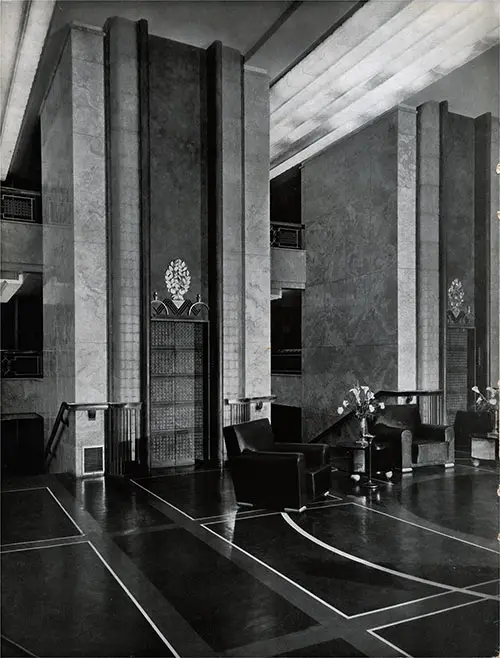
The First Class Social Hall. | GGA Image ID # 1266c2e600
Let's go to NEW YORK...
Through the open door in its side, we enter the ship and find ourselves in a palace. A huge hall of a pleasant amber color welcomes us.
Clad in Algerian onyx, enhanced with patinated and gilded copper fittings, the walls take on their full value between the floor, covered in black and dark blue, and the very luminous ceiling light which constitutes, like beams blocking the hall on its entire width, two groups of three molded glass elements.
Four elevators with cages sheathed in gilded bronze connect the seven floors of the ship to this central square where staircases also converge.
This is where your friends will accompany you through the hubbub of arrivals and departures. You will pass through it to go down to the dining room, from which a monumental door separates you, or to go to the chapel, on the other side towards the front.
Note on the first landing of a monumental staircase, the panel which closes the hall, and bears the symbol of Normandy in the form of the “NORMAN KNIGHT”.
The Hall is two and a half height between decks, and you can see on each side the passageways of decks C, B and A. On the intermediate floor, you will find the offices of the Commissioners, smiling housemasters, the Office of Information with its attentive and discreet reception staff, the very Parisian windows of the “Bon Marché”, the Hairdresser's salon, that of the Florist, the Tourist and Railway Office.
“The Norman Knight” by Schmied
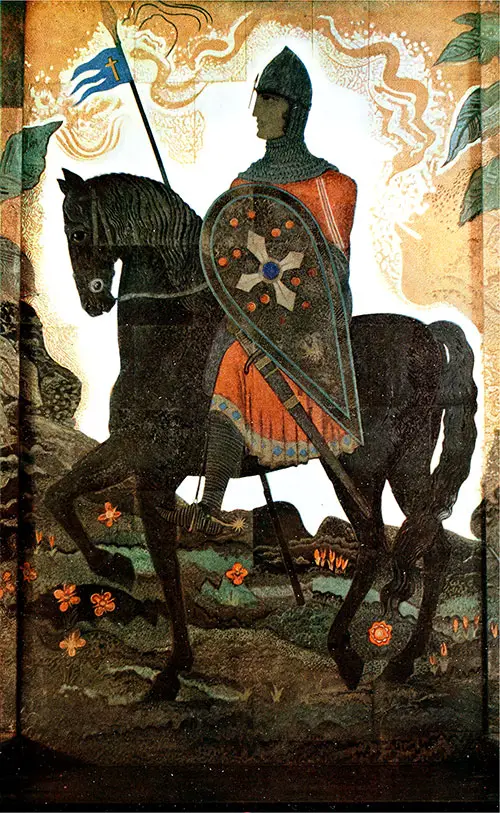
The Great Tapestry “The Norman Knight” of Schmied. | GGA Image ID # 1266ceb5e5
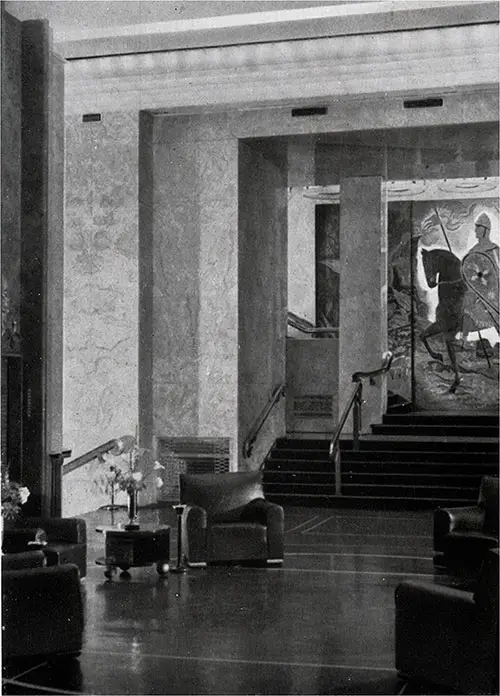
The Great Tapestry in the Social Hall. | GGA Image ID # 1266de8d17
The remarkable champlevé cloisonné enamel panel created by Mr. Schmied “Le Chevalier Normand” is the first piece of monumental enamel and the first type of this technique based on engraving.
The artist conceived the idea of depicting a Norman Knight, an anonymous officer of William the Conqueror, without however locating him in a Norman site, in order to preserve his great legendary character. He gave free rein to his imagination, seeking above all to bring out from the rhythm of the whole a feeling of tranquility and nobility.
For the costume, the author was inspired by the marvelous Bayeux tapestry.
Mr. SCHMIED was led to make a connection between his wood engravings and the relief obtained by Baudin's iron castings. A long study led to the creation of a workshop intended for the manufacture of monumental enamels.
The wooden plaques engraved by the artist, transposed into cast iron, gave in fact all the elements of the “champlevé” enamel technique, which consists of digging into the metal cells or compartments intended to receive and retain the enamel powders then solidified by firing at a thousand degrees.
By treating his engraving with the greatest freedom, the artist obtained pictorial effects of great preciousness. Same vibration as in woven tapestry, with greater intensity of color and the ability to design without limit of size by braving all bad weather and all climatic variations.
The large outdoor tapestry was created.
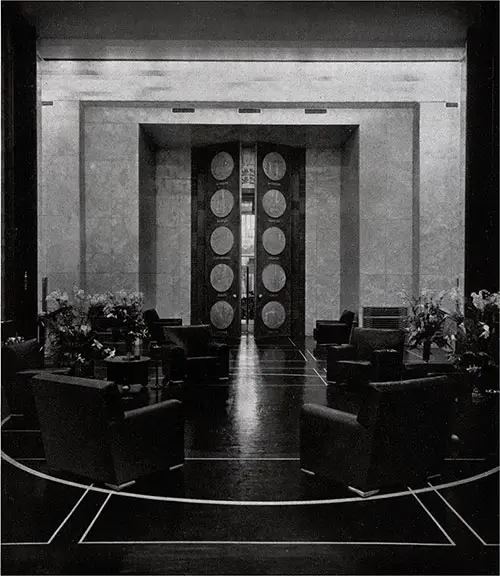
The Subes Door of the Social Room. | GGA Image ID # 12672b5a7a
The Subes Door
A monumental door 6 meters high in antique green patinated bronze opens onto the dining room. Its author is Mr. Subes. It is decorated, on one side, with io circular cabochons in relief, gilded, representing the Normandy cities: Le Havre, Alençon, Lisieux, Saint-Lô, Cherbourg, Falaise, Rouen, Caen, Evreux, Dieppe.
The other side is golden. She wears a fishnet with a shell and a group of three signs, symbols of the sea.
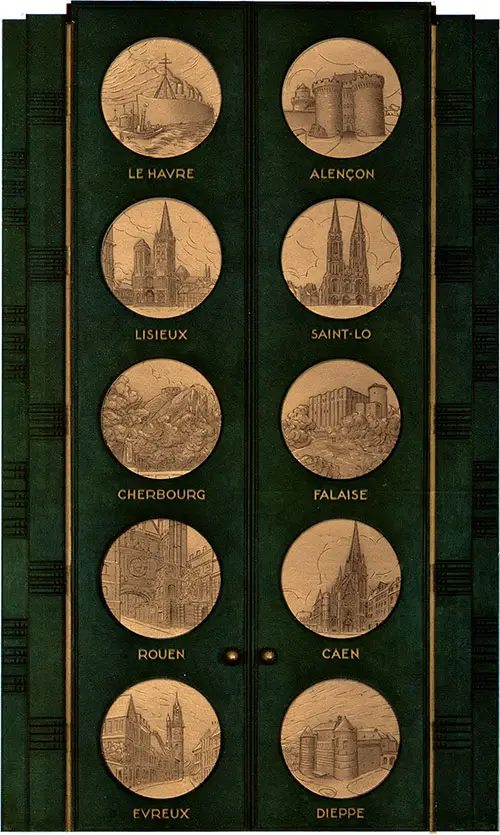
Close-up of the Subes door. | GGA Image ID # 12679d5aa7
The Dining Room
In Ship Tax and following the hall extends the luminous perspective of the monumental dining room whose dimensions have been compared to the Hall of Mirrors at Versailles.
So much air and light, beauty and freshness in this room with such harmonious proportions! The burnished gold reflection of the coffered ceiling, the purple stream that emerges from the molded glass walls, the clarity of the sconces and the shine of the fire pots contribute to creating a brilliant atmosphere, which marvelously bathes the 241 flowered tables, decorated the elegance of 700 guests and the sparkle of crystals.
Eight small private dining rooms open on each side. They each have their own character.
Alternating with the glass elements of the walls, blood breccia marbles frame four bas-reliefs in gilded staff evoking the resources and various activities of Normandy, which adorn the narrower parts. This room ends with the lower banquet room which, in proportion, seems small despite its 72 seats.
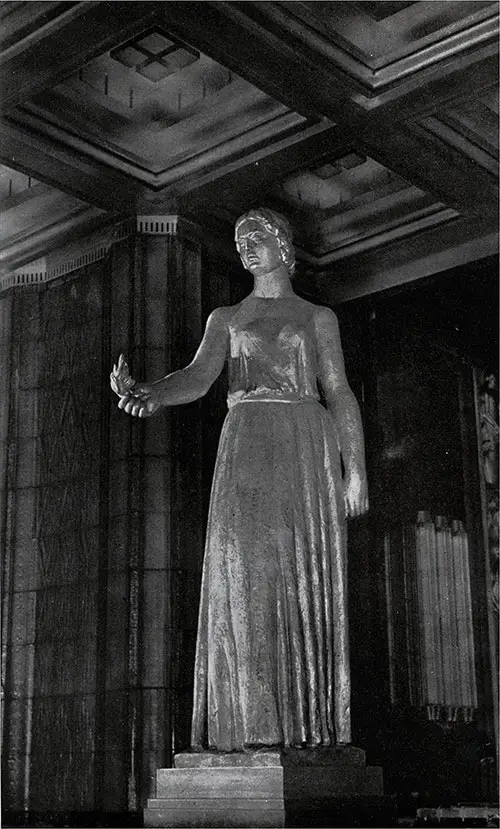
Statue Leading to the Entrance to the Dining Room. | GGA Image ID # 1267e2ad8b
Some figures. — Let us illustrate the monumental character of this dining room with a few figures.
Its dimensions are 86 meters for length, 8 m. 50 for height, 1,100 square meters for area.
The weight of the glass elements which make up the walls amounts to 60 tons, to which must be added 25 tons of metal frames.
135,000 candles diffuse their lighting in abundance.
The volume of this admirably airy room is more than 6,000 cubic meters. The conditioned air which ventilates it arrives through ventilation ducts, due to the CARRIER house and hidden in the ceiling boxes.
The walls, the lights. — The architects' desire was to use new materials providing complete safety from the point of view of incombustibility. They adopted glass in the form of molded slabs, engraved, chiseled and made slightly sparkling by a metallic background. The appearance is shimmering. The walls are streaming with light without being luminescent, thanks to the wall coverings by Mr. LABOURET.
During extensive research, this artist thought, given the fragility of the stained glass window, of using thicker glass and partitioning it with cement. But this glass of equal thickness is monotonous: to bring it to life, he shatters it with a hammer and thus obtains a thousand sparkling facets - an entirely new technique.
For the lighting elements, the architects turned to Mr. LALIQUE, a glass poet who designed monumental wall lights 5 meters high and 3 meter fire pots, from which light radiates. Here, the glass treated by LALIQUE is molded or pressed.
In this way, fixed but varied landmarks support the architectural and decorative order, at the same time as they give the eye and the mind an essential impression of order.
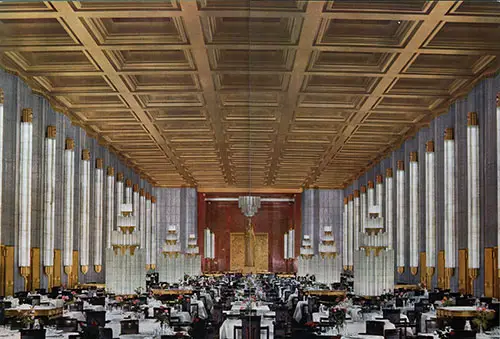
The First Class Dining Room. | GGA Image ID # 1268116efa
The four bas-reliefs. — These bas-reliefs, of unusual dimensions, were made of golden stucco to remain in harmony with the room and to be able to successfully withstand the test of the light shed in profusion.
These four bas-reliefs being entrusted to four sculptors, a first problem arose: ensuring sufficient unity to avoid disagreements overall.
After preliminary studies, the interested sculptors adopted the following approach: a group of two large standing figures constitutes the center of each subject, complete freedom being left to each artist for the choice of attitudes and style of the central group as well as for the general composition.
Mr. DELAMARE traces regional Arts and Monuments.
It is through great people that the artist expressed Art in Normandy and its main eras. His figures symbolizing Romanesque art, Gothic art, the Renaissance and the 18th century, are evocative, without precise reminiscences. However, the first supports the Abbaye aux Hommes of Caen, the second the Gothic Cathedral of Rouen. As for the figure of a woman recalling Renaissance Art, it is based on a fragment of the Bourgthcroulde Altar in Rouen, the center of which is made up of the porcupine of Louis XII.
On the right and below, the arms of Normandy supported by a heraldic lion.
At the top of the bas-relief, Saint Michael slaying the Dragon - very rich decorative elements, highlighting the gilding and justified from a historical point of view by the choice of Saint Michael, patron saint of Normandy and of Rollo, who consecrated the "Mont ".
Finally, at the top, on the right, two horsemen, William the Conqueror and one of his companions, the inscription “Marc Transivit”, the longship of the Vikings, three elements taken from the famous Bayeux Tapestry.
Various smaller figures complete the composition. Regional industries and arts are evoked by three characters: the coppersmiths, whose small town of Villedieu is home to traditional copper working, the earthenware makers, the drapers of Elbeuf.
The bas-relief is entirely gilded with leaf on a beautiful red plate.
Opposite, the bas-relief of Mr. Léon Drivier: Sports and Games.
The two athletes from the center express in their relaxing rhythm the joy that animates a healthy organism whose sport has developed the living and powerful architecture. With the athlete lying below them, they symbolize the classical element of the composition for which they serve as a fulcrum.
The polo player, the two dancers above, the group of women in the canoe, on the left, bring on the contrary the contrast of the action pushed to the lyricism of the forms.
The energy of the rider and his horse all contracted in a sudden stop, the tense accent and the assertive lines which translate this energy are opposed to the languid and full forms of the dancers, while the grace of the women in the canoe expresses the vigor demanded by the sport.
Branches of apple trees, movements and splashes of waves, distributed here and there, synthetically create the atmosphere. In the framework thus organized, the artist wanted to plastically represent an aspect of modern life.
The bas-relief by Mr. Pierre Poisson represents Maritime Normandy.
The artist did not hesitate to use allegorical language. It is the multiple life of the Ocean, symbolized by certain deities or by still life. The characters only make gestures of contentment. Abundance is everywhere; Radiant Venus. Quick Mercury commands the action that others perform while playing.
The artist also wanted balance, variety in symmetry, and, everywhere, a general rhythm which passes from figures to draperies, to divinities, to waves.
The fourth bas-relief represents Earthly Normandy.
The artist, Mr. Pommier, was inspired by Norman pastures and orchards, beautiful animals and trees laden with apples. At the center of his composition, he planted the characteristic apple tree; other trees, at the upper and lower angles, impose the view of the orchard; next to it, the sheaves are piling up. The characters live according to the Norman Land.
Nature, men, animals: it is with them that the artist wanted to compose a song in honor of Normandy, its riches, its beauty.
The monumental statue of Mr. Dejean, which overlooks the Commander's table, symbolizes France's peaceful welcome. This vertical was necessary to dominate the lower part of the tables and seats.
Small Dining Rooms
Eight painters gave their particular character to each of them.
Madame Chantaud-Chabas dedicated four paintings in bright and cheerful tones to the great Norman products: Cider, Milk, Harvest and Fishing.
Mr. Degallaix symbolized Spring.
Mr. Léopold Lévy spoke about Summer.
Mr. Gaboriaud was inspired by the scenes of Autumn.
Mr. Mehcut, whose subject was Winter, painted the forest of France in winter populated by its animals.
Mr. de la Nezière represented famous monuments in very warm monochrome: the Renaissance Château de Fontaine Henri, near Caen; Château Gaillard, from the Middle Ages; the Bayeux Cathedral, and, finally, the Romanesque Basilica of Jumièges.
Mr. Edy Legrand took as his theme the Harvest, the Norman Farm, the Sea, the Orchard.
Mr. Bouchaud represented exotic fruits, oranges carried by Moroccan women, coconuts picked by Indo-Chinese, dates picked by Kabyles, bananas in bunches handled by women of color.
The Banquet Dining Room
In this room with old pink tones, the indirect lighting highlights M. d'Espagnat's ceiling in blonde tones: Dance, Music, Flowers and Fruits are evoked by figures of women and children.
The ceilings of the cells were entrusted to Mr. Picart le Doux, painted in monochrome, white, and enhanced with gold: Norman attributes, stars.
The back niche is a magnificent bas-relief by Janniot. The subject chosen by the artist is the following: Normandy in the brilliance of its history extends, from the banks of the Seine to the shores of the sea, the richness and beauty of its soil.
Normandy is represented in the form of Pomona and seated in its crest in the colors of the former dukes of England. This figure connects the Seine to the English Channel. In the center and below, the three main figures symbolize the country of Bray, the country of Caux, the country of Auge.
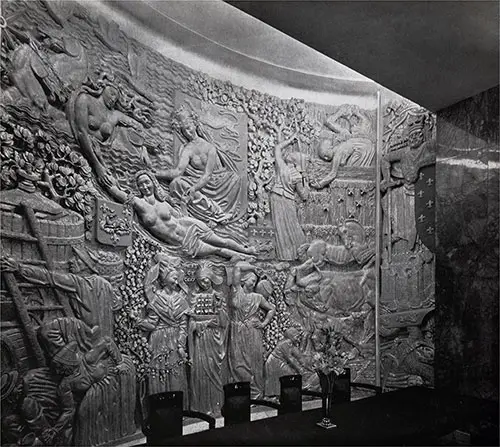
Normandy by JANNOIT. | GGA Image ID # 1268157b09
THE CHAPEL
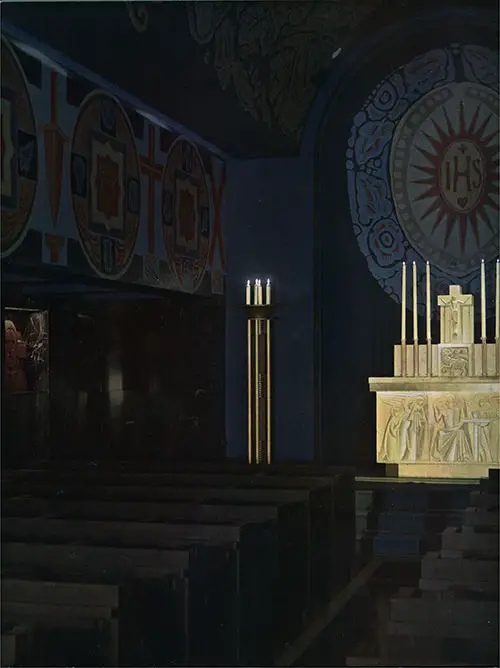
The Chapel - the Sign of the Norman Knight has been Obliterated. | GGA Image ID # 12681c15de
The Chevalier Normand sign has just been erased. A sober style altar shines in the darkness of the Chapel, whose mid-cylindrical vault and supports seem woven with patterns in blue and purple tones.
In the shadow of the aisles, covered in black marble from the Pyrenees, fourteen panels mark the Stations of the Cross. Everywhere appear the four elements of Christian iconography: ear, vine, rose and palm.
The atmosphere is indeed that of a very collected chapel, very far from the shiny world and favorable to prayer and meditation.
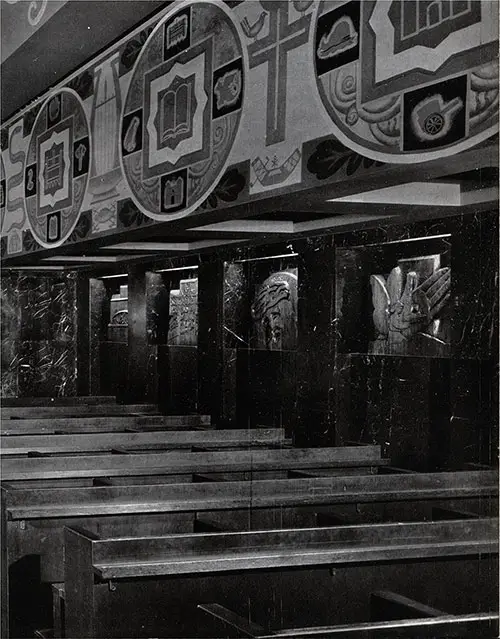
Sculptures in the Chapel. | GGA Image ID # 126852f376
The decoration of the Chapel is by Mr. Voguet. The altar, the candelabra, the organ gallery are by MM. Martel, the stalls of Leglas Maurice and Jamin.
The admirable stylized figures of the Stations of the Cross were carved from dark rosewood by Mr. Le Bourgeois.
A Stations of the Cross, from a strict liturgical point of view, is a series of fourteen wooden crosses, necessarily fourteen in number and necessarily made of wood.
This is what the artist wanted to achieve. The general shape of the whole is made up of crosses; the characters simply come forward to recall the action attached to each station.
Only the figure of Christ is large in scale. Whenever possible, a large figure alternates with a decorative composition.
During the Services of Reformed worship, the altar and the stations of the Stations of the Cross are hidden; a pulpit and two candelabra are installed on the steps.
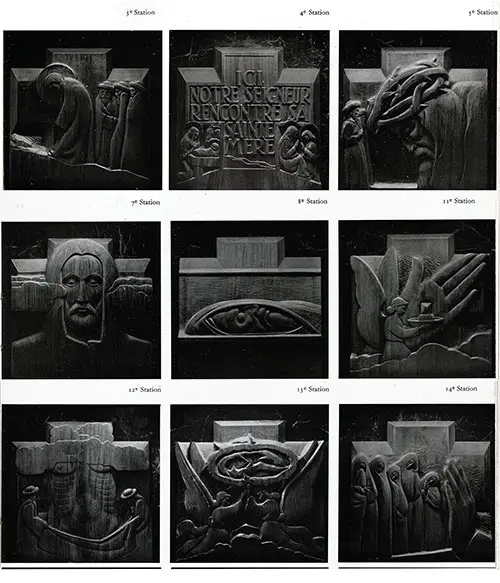
The Third to the Fourteenth Stations of the Chapel. | GGA Image ID # 1268815900
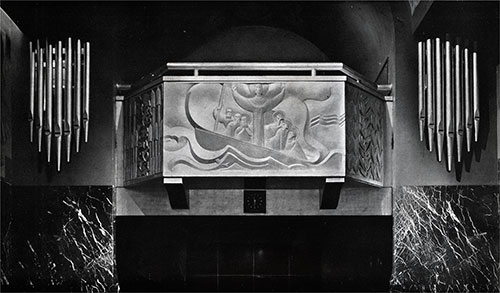
The Organ Tribune. | GGA Image ID # 1268cc460a
The Performance Hall
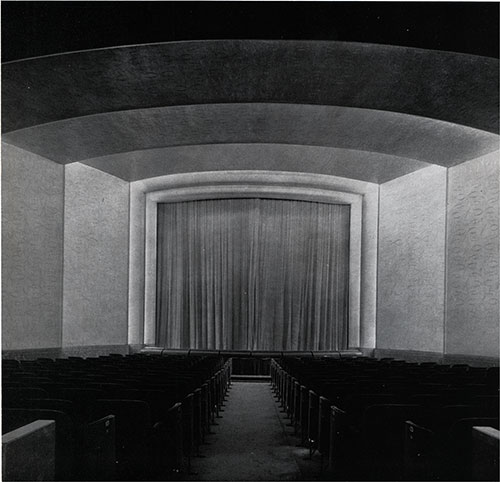
The Theater on SS Normandie. | GGA Image ID # 12691173bc
From the Hall we went upstairs to the Promenade Bridge. It is here that social life finds its most brilliant setting in this row of reception rooms which, from the Theater, placed under the first fireplace, follows the axis of the ship crossing the Salon Gallery, the Grand Salon and the Smoking Room , leading to the Café-Grill whose immense bays open onto the sea – this whole being surrounded by the Promenade Bridge.
The Theater with its clear silver tones can accommodate more than four hundred spectators; it is equipped in a very modern way and its acoustics are perfect. On the stage, equipped with complete machinery, a screen is installed in the afternoon which allows performances from 2:30 p.m. to 7 p.m. a continuous cinema show.
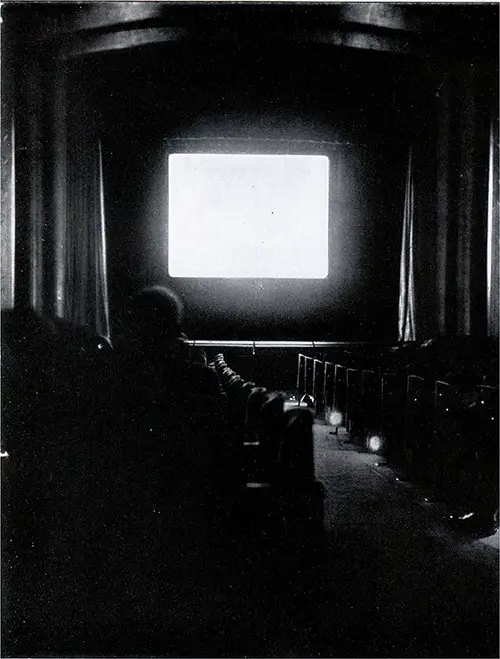
Film Showing in the Theater on the Normandie. | GGA Image ID # 12692301c2
This is how many Americans can learn about French drama and cinema, both during the crossing and in New York during galas. “NORMANDIE” therefore still deserves the name “ambassador liner” here.
The Upper Hall
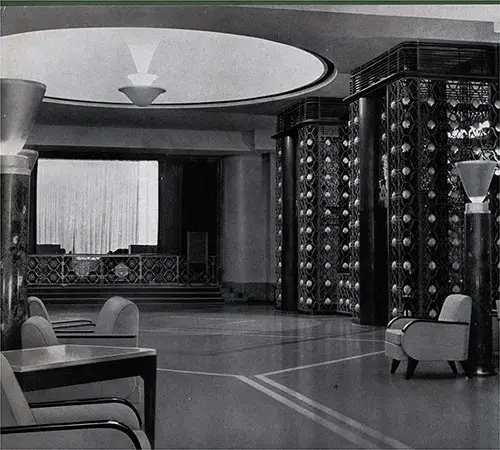
View of the Upper First Class Hall. | GGA Image ID # 12696d077d
Once crossed the threshold of the Performance Hall, which is closed by a gate by Mr. Subes, the crowd crosses the “Upper Hall” which is decorated with four bas-reliefs, carved by Mr. Saupique in the stone, then it flows into the Gallery-Salon.
The Bas-Reliefs of Mr. Saupique
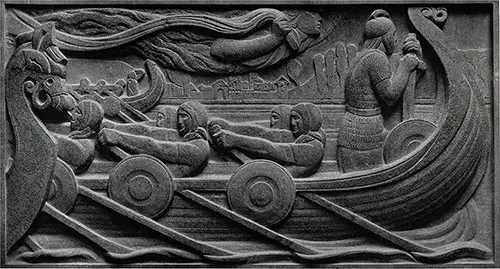
The Goddess Freia and the Drakkars, Bas-Reliefs from SAUPIQUE. | GGA Image ID # 12697f44fc
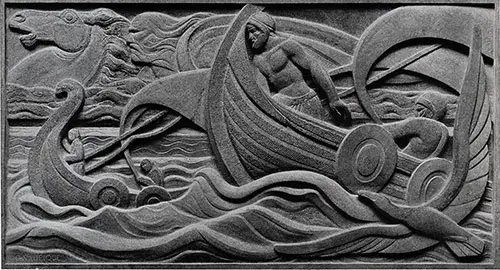
The God Odin in the Storm, Bas-Reliefs from SAUPIQUE. | GGA Image ID # 126a5897d5
The general theme of the bas-reliefs of M. Saupique is the legendary Normandy Alaritime On the one hand it is the evocation of the mythology of the Vikings: Odin on his storm horse takes two longships tossed by a stormy sea towards adventure.
In the foreground a large albatross spreads its wings. A Valkyrie, torch in hand, flies over a flotilla of longships rowing up a river.
On the other side is the memory of the Sagas of the Norman conquests. The companions of Erik the Red, covered in animal skins, reach the region of the icebergs.
In the foreground a menacing polar bear and a sperm whale. The author wanted to express the poetry of the sea and adventure in a primitive and wild atmosphere. The impression of depth was studied by successive shots, the first of which are almost life-size.
The Salon Gallery
This gallery which leads to the Salon is decorated with two mounted panels by Mr. Ducos de La Haille, and four bas-reliefs by Mr. Bouchard. It is lit by eight alabaster vases from Bagués supported by thin stucco columns.
The Compositions of Mr. Ducos de La Haille
In the “Norman Conquest” we see the glorious Viking Rollo setting out to conquer Normandy. Frigga, goddess of nature and fruits, divine wife of Odin, directs him and protects the heroes. In the distance, in the Seine estuary, the rapid longships enter in numbers.
“Norman peace” makes the rich province flourish between the trees and among the apple blossoms. On its rock, Saint-Michel-au-Péril-de-la-Mer dominates Jumièges as well as the Abbaye aux Hommes, the Abbaye aux Dames and the Madeleine, witnesses of times gone by and civilizations accepted by opulent and joyful peasants . Horses graze the grasslands and the warlike fleet of longships has given way to the light and peaceful flotilla of Norman fishermen.
The Bas-Reliefs of Mr. Bouchard
These bas-reliefs of more than two square meters, in Cru Chand stone, are placed in iron frames and supported by elastic joints.
Commerce is symbolized in the form of young women making trades. One of them displays draperies — while dockworkers pile up bales of cotton.
The other two represent “Norman Fishing” and “Norman Farming”.
Finally, the fourth bas-relief shows on one side a worker from Alençon performing the famous lace stitch with a needle. In front of her, a veiled woman holds in her hand the model of the famous church of Saint-Etienne in Caen.
The entire background of the composition is decorated with architectural silhouettes evoking monuments in the Norman Roman style. From left to right: Mont Saint-Michel, Saint-Martin de Borchenville, Jumièges Abbey and Château Gaillard des Andelys.
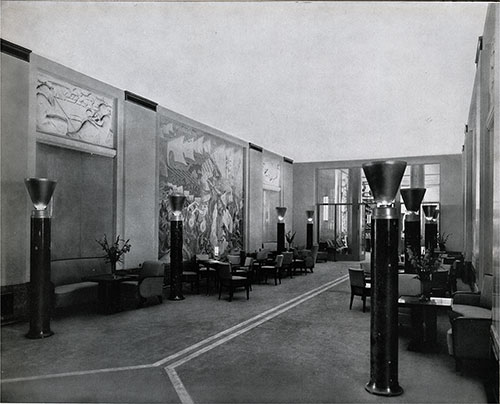
In the Salon Gallery: two bas-reliefs by BOUCHARD, Norman Livestock (on the foreground) and Commerce. in the center: the Norman Conquest composition by DUCOS DE LA HAILLE. | GGA Image ID # 126a787a27
The Grand Salon
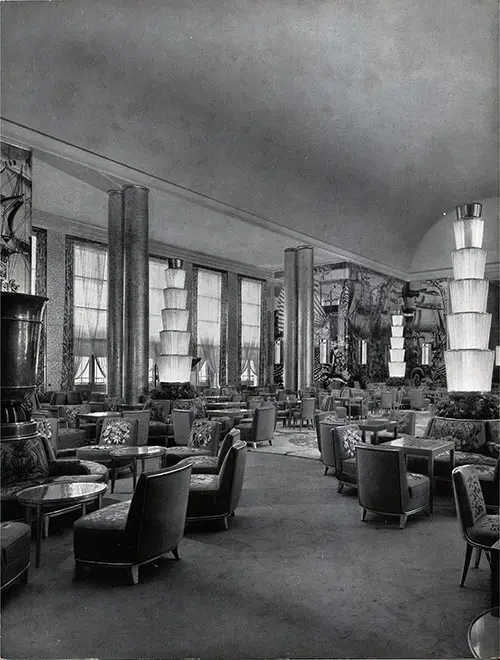
The Grand Salon of the First Class. | GGA Image ID # 126a9fb4ff
The Grand Salon is immense and luminous, brightly colored: columns and gold lacquers — gilded, silvered and burnished mirrors — silks, tapestries and carpets dominated by a slightly orange red, a warm gray, a slightly greenish yellow, harmonizing their dazzling tones while silks lightly drape the windows overlooking the sea.
Its imposing dimensions make it possible, like those of all the common areas of the liner, to accommodate all passengers at the same time. Its surface area reaches 700 m2 and its height 9 m. 50.
The walls are decorated with mirrors, on which gold, silver, platinum and palladium trace immense figures drawn by the master glassmaker Champigneules from the cartoons of Mr. Dupas who also sculpted a monumental door in golden lacquer which we can conceal.
Mr. Gaudissard designed furniture for Aubusson and this brightly colored carpet, which covers an 80 m2 dance floor, a faithful reconstruction of the parquetry of the Throne Room in Fontainebleau.
Lighting is provided by wall lights and four large molded glass floor lamps. Projectors, hidden in artistic vases, illuminate the dome of a ceiling without overload.
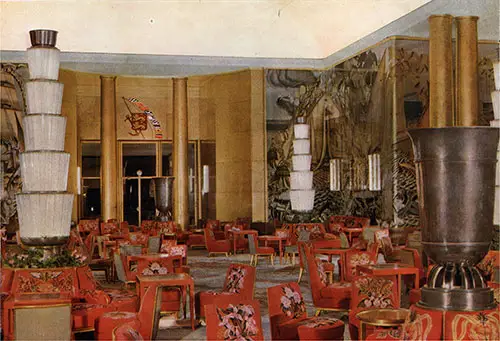
Towards the Salon Gallery and the Upper Hall. | GGA Image ID # 126ab1dd00
Two small Salons overlook the Grand Salon: one is reserved for ladies and is decorated with furniture by Ruhlmann and painted panels by MM. Graux and Prunier; the other is reserved for correspondence and the library.
Mr. Dupas' panels, in decorated ice, evoke the different eras of navigation and their naval architecture, the sea and its Gods, the Clouds, Europe, the birth of Aphrodite, the Chariots of Thetis and Poseidon. They measure 6 m. 50 meters high and 15 meters wide.
Mr. Dupas created bas-reliefs on lacquer of the large sliding door, pierced by two smaller doors. A compass rose, against a background of waves, serves as the center of its composition which represents the winds and the chariots of Dawn and Night.
The knotted carpet, the largest ever made, measures 8 meters by 12 meters, and weighs 450 kg. Ten workers tied its eight million stitches over three months.
For the eight 6 meter high windows, the harmoniously designed silks by Jean Beaumont have the motif of clusters of cherry wisteria on a white satin background; the curtains, measuring 500 square meters in total, were woven by Maison Cornille.
Note the panels of the small lounges.
Mr. Ballande painted a view of Etretat taken from the top of its cliffs.
Mr. Graux's painting is inspired by the lower Seine Valley.
A ceramic panel, made at the Manufacture Nationale de Sèvres by Mr. Prunier, evokes the legend of the Tidal Bore, this bar of the Seine fighting against the waves of the sea going far inland. Mr. Jean Beaumont showed the meeting of the Seine and Neptune accompanied by the nymph Heva, who rests under the Cap de la Hève.
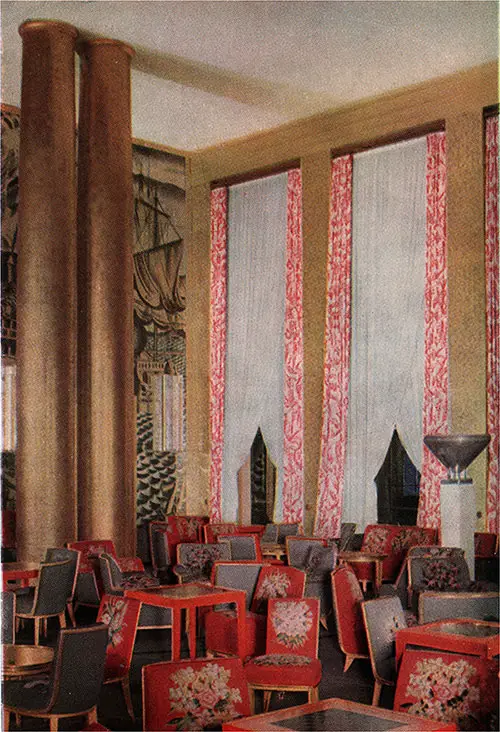
View from the Corner of the Living Room Gallery. | GGA Image ID # 126ac9eb60
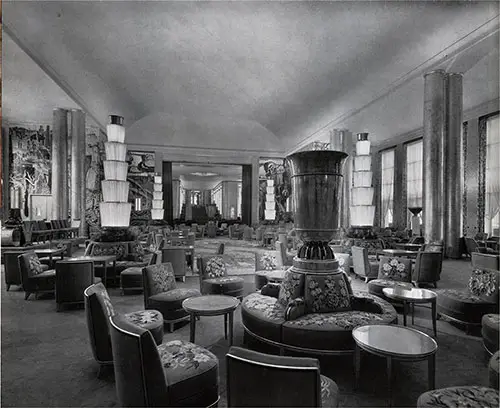
Towards the Grande Descent and The Grill. | GGA Image ID # 126ae2c5ae
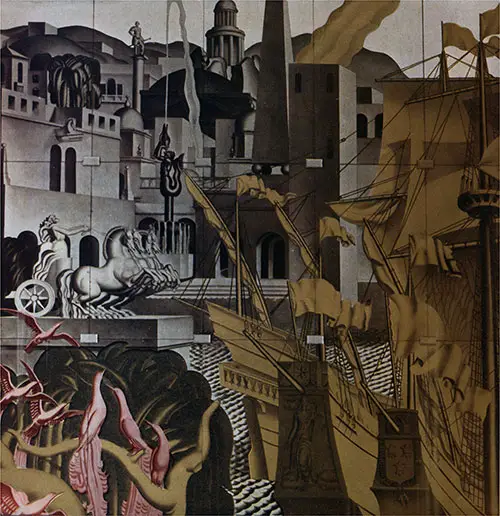
Detail of a DUPAS Panel. | GGA Image ID # 126aede3c6
The Smoking Room
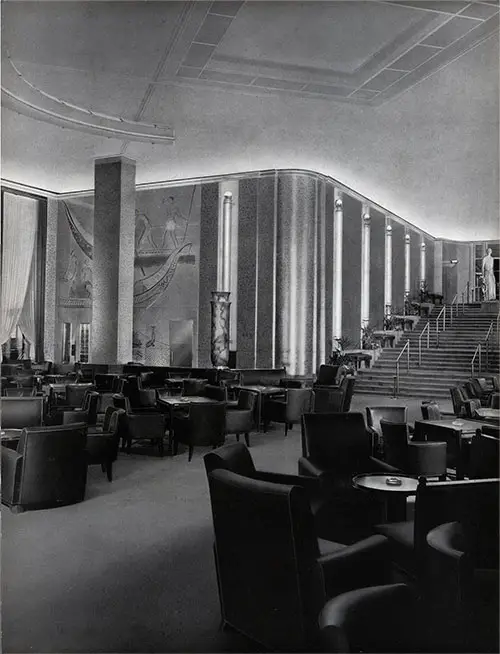
First Class Smoking Room. | GGA Image ID # 126bf284b7
The elegant smoking room is famous for the splendid covering of its walls entirely covered by Mr. Dunand with Coromandel lacquer panels.
This artisan created a masterpiece of patience and perfection by sculpting “the Games and the Joys of Humanity”, “Sport”, “Fishing and Hunting”, “the Conquest of the Horse”, “ the Harvest” and “the Dance”. A lacquer of gold leaf lets the lacquers of brown tones shine through; the relief of these panels is very vivid.
The Smoking Room receives its light from large windows overlooking the Promenade Bridge and the boat deck.
The ceiling, which is made of staff, has a light decoration. The side parts are lit by spotlights fixed in decorative alabaster vases surmounting fixed furniture forming benches. Large light sconces are placed in niches around the perimeter.
The furnishings further include tables, large comfortable armchairs and lighter seats, all covered in brown morocco.
A monumental staircase, which seems golden by the setting sun, leads to the Grill. At the top, a statue, a beautiful work by Mr. Baudry, represents “Normandy” leaning on an apple tree. From this point, the view extends uninterrupted for three meters to the Theater stage.
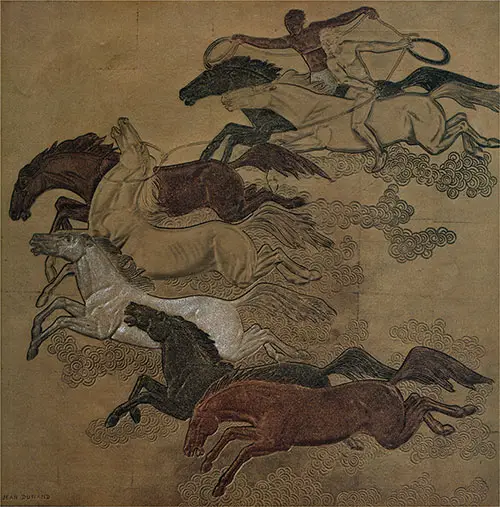
The Conquest of the Horse. | GGA Image ID # 126c1a8fee
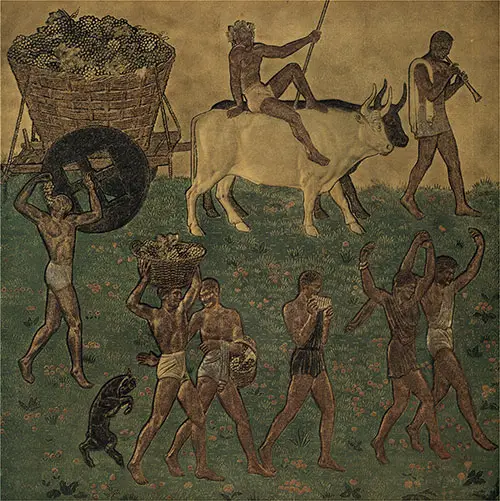
The Harvest. | GGA Image ID # 126c72d1af
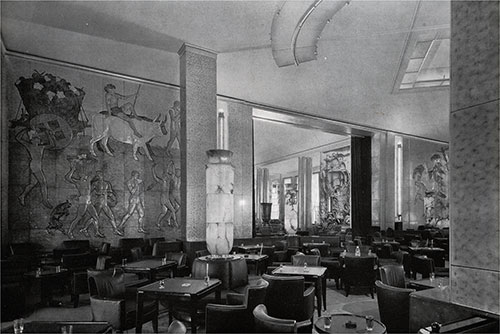
A Corner of the Smoking Room and the Entrance to the Grand Salon. | GGA Image ID # 126cfc2239
The Lacquers of Mr. Dunand
Its four panels each measure 6 meters high by 6 meters wide and the large door measures 6 by 8 meters.
They are made up of the obviously very delicate assembly of juxtaposed blocks of lacquer which have been left independent to enable them to follow the movements of the ship. Each is set in a yellow copper frame which is hung on a metal frame. One thousand and seventy-eight blocks, of which at most fifteen are identical, were made to the desired dimensions.
Mr. Dunand himself sculpted all the figures with a gouge and rasp, in bas-relief on the flat bottom of each element. This sculpture is reminiscent of Egyptian bas-reliefs through its technique, part – let us remember – of copper engraving.
The designs were coated with different brightly colored lacquers, and leaf gold applied on the final fresh coat. Once hardened, the gold was worn down with powdered charcoal to obtain greater or lesser transparencies.
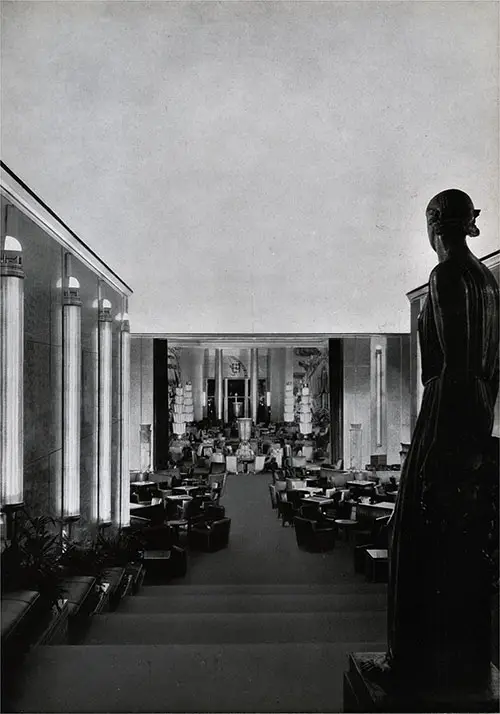
The Great Descent, the Smoking Room and the Living Room. | GGA Image ID # 126d1b865e
The Grill Room
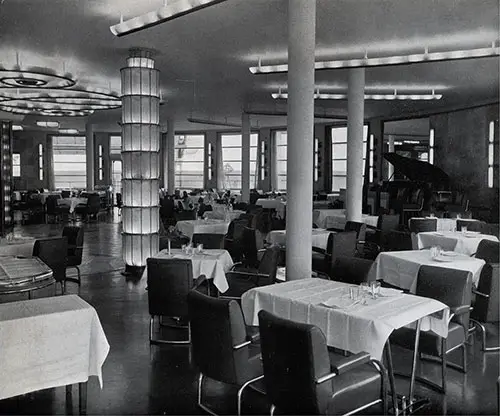
The Nightclub Grill and Gathering Place. | GGA Image ID # 126d1fc448
The cheerful meeting place for passengers, the “Night Club” is this grill whose immense windows open onto the sea. Its decoration is in varnished pigskin. A vast arabesque and radial bands attached to the ceiling diffuse the light. In the center, a 50 m2 oval dance floor in oak marquetry with rosewood, mahogany and walnut motifs.
An all-black Grill complements an all-white Bar. One is decorated with an enormous cast iron plate surrounding the oven, which Mr. Hairon illustrated with animal engravings. For the other, an engraved glass plaque decorated by Mr. Max Ingrand, takes bottles and vines as its subject.
The grill annexes — private bar and private dining room — were decorated by Mr. Gernez.
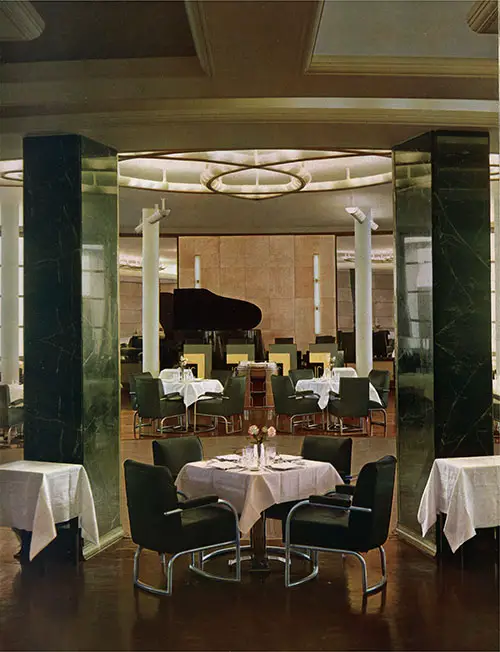
The Grill Restaurant for First Class Passengers. | GGA Image ID # 126dc3ce23
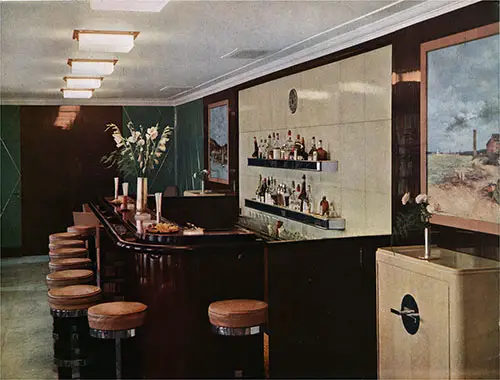
The Private Bar. | GGA Image ID # 126df8a266
The Promenade Bridge
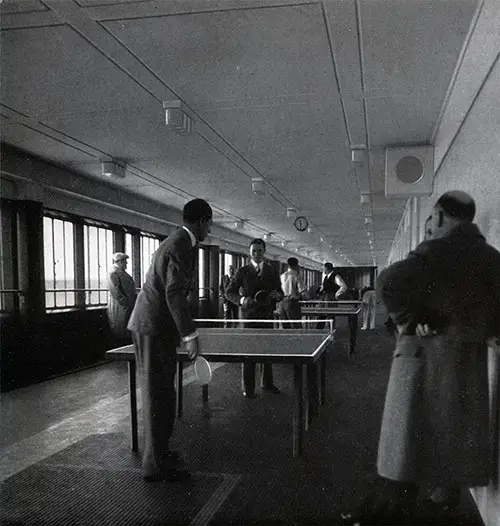
Passengers Play Table Tennis on the Promenade Deck. | GGA Image ID # 126e3a6546
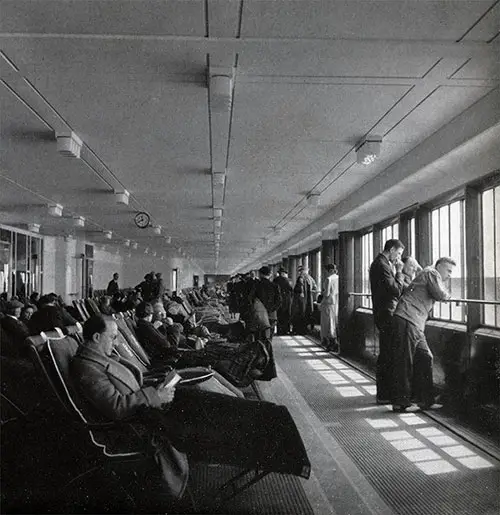
Passengers Relaxing on the Promenade Deck. | GGA Image ID # 126e8760b2
During the four days that the crossing lasts, sports enthusiasts do not have to fear losing their shape: the Promenade Bridge extends its kilometers of sheltered promenade - the swimming pool, located on Deck D, below the chapel, offers their nautical frolics in the 175 m3 of its green water.
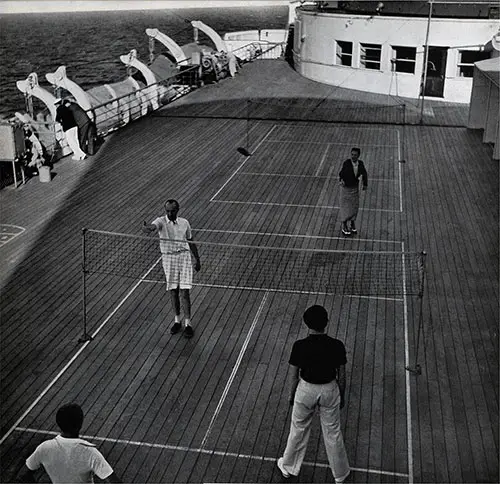
Passengers on the Sundeck. | GGA Image ID # 126e964d9c
Tennis gives them a court of regulatory dimensions between the second and third chimneys. The sundeck shared by shelters which protect from the wind, allows you to indulge in deck games, after the fatigue of mechanotherapy.
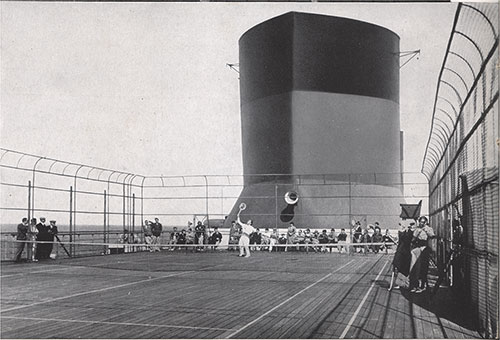
The Tennis Court on the Sundeck. | GGA Image ID # 126f0d4838
Let us also mention the pigeon shooting, the shooting range, the numerous Ping-Pong tables and the golf facilities.
The Swimming Pool
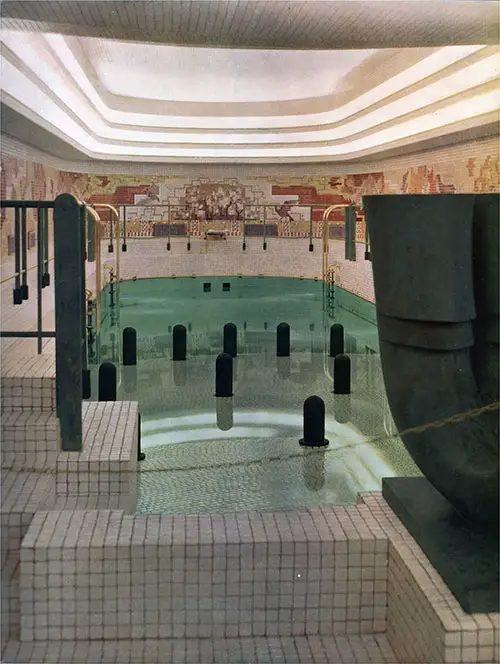
The First Class Passenger Swimming Pool. | GGA Image ID # 126e8f7682
The swimming pool measures 25 meters by 6 meters wide — its walls are covered with white and bluish enameled sandstone tiles. A ceramic from the Sèvres Manufacture, executed on Mr. Menu's cartoons, surrounds the gallery which dominates the bath with its frieze. Steps allow you to gradually enter the green water, which is illuminated by lighting, until you lose your footing in the deep tank.
The ceiling is violently illuminated by an element of sculptural composition, made in antique bronze by Mr. Chauvin, and placed on the beach where bathers meet near the bar, an elegant meeting place. Admirably equipped mechanotherapy room, cabins, hydrotherapy and massage rooms are nearby.
The Winter Garden
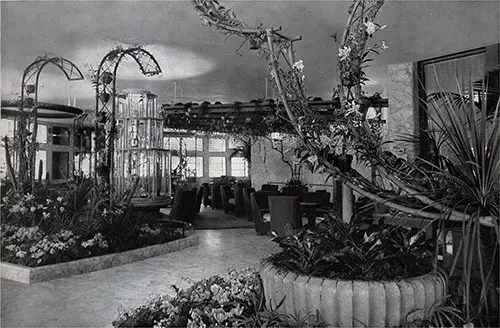
The Winter Garden of the SS Normandie. | GGA Image ID # 126f21c2eb
“Normandie” takes a little of the earth of France, its flowers, its roses, its lilies, in this admirable garden entrusted to the vigilant care of the house of Vilmorin, which opens in a rounded facade on the front of the ship, above the Promenade Bridge.
Flowerbeds, pergolas and glass greenhouses along the windows constantly bear the most beautiful flowers. Two aviaries, full of pretty birds, surmount, in the center of the garden, basins where fountains flow.
The hammered bronze statue — a sea lion — is by Mr. Lacroix.
At the rear of this winter garden are two lounges reserved for correspondence and reading, decorated with panels representing the royal tigers, the sacred elephants of Hué, painted by Jouve and a rural scene by Jacovleff.
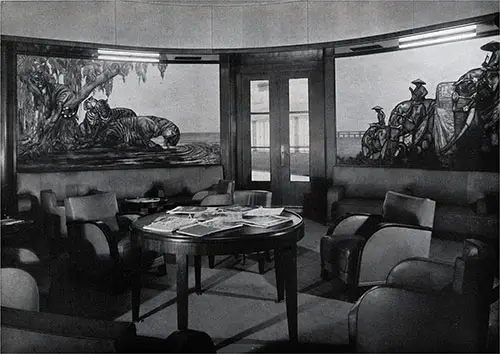
The Reading Room. | GGA Image ID # 126f3cbf7b
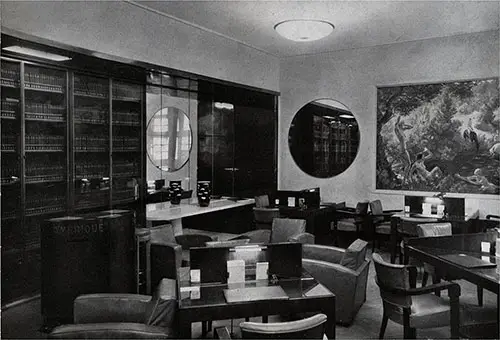
The Correspondence Room (or Writing Room). | GGA Image ID # 126f8bad49
Children
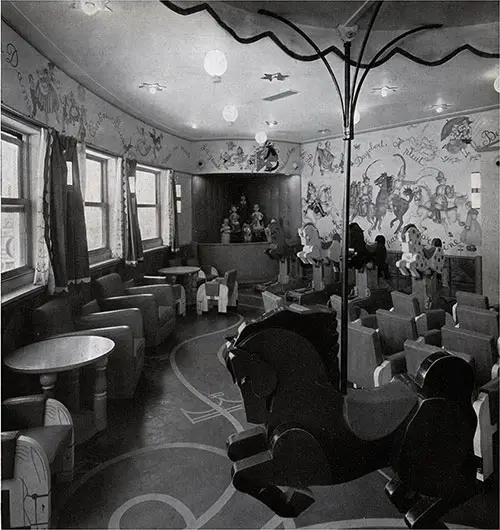
The Children's Playroom. | GGA Image ID # 126fb67275
For the little ones, a Nursery, with a particularly clean appearance, contains all the necessary devices. Next to it is the dining room designed very practically with its buffet, by Mr. Philippot. On the green walls Mr. de Brunhoff applied a nice cut-out of elephants. A games room placed under the front fireplace offers children a Guignol theater, a massacre game, a merry-go-round.
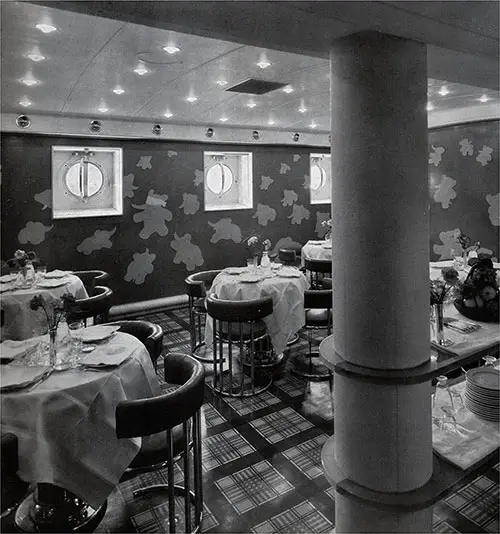
The Dining Room for Children (Mr. PHILLIPOT, architect). | GGA Image ID # 126fdb2861
Apartments And Cabins
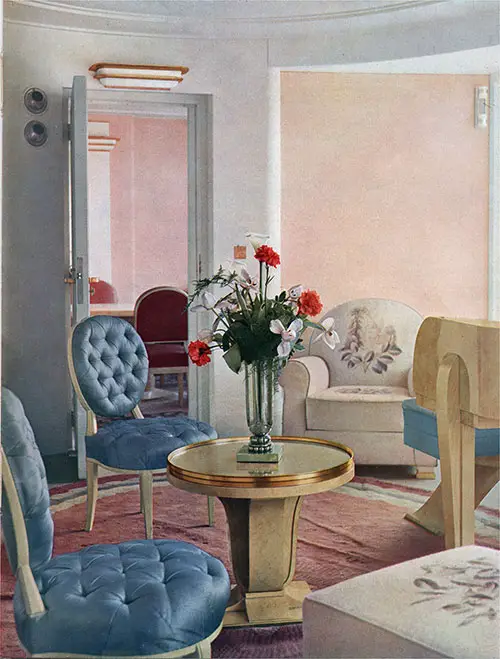
A Luxury Apartment with Terrace: “DEAUVILLE”. The living room (SUE, decorator). | GGA Image ID # 12703ad955
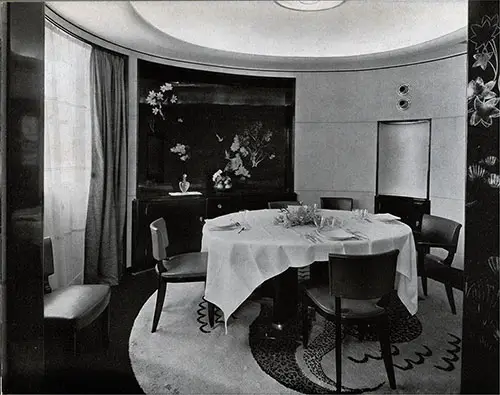
The Dining Room. A Luxury Apartment with Terrace: “TROU VILLE”, (LELEU, decorator). | GGA Image ID # 12704a6a34
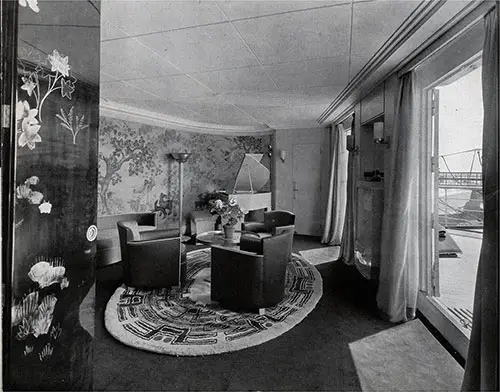
The Living Room. A Luxury Apartment with Terrace: “TROU VILLE”, (LELEU, decorator). GGA Image ID # 1270852e6d
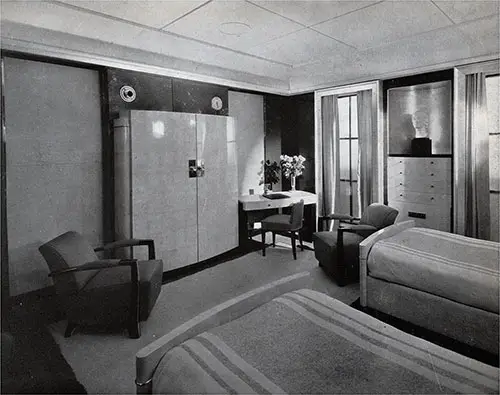
A Bedroom. A luxury apartment: “ROUEN” (DOMIN, decorator). | GGA Image ID # 1270f16898
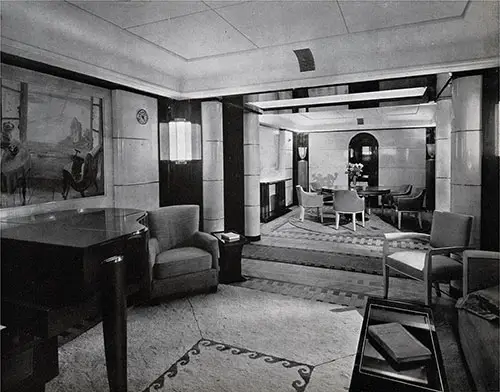
The Living Room and the Dining Room. A luxury apartment: “ROUEN” (DOMIN, decorator). | GGA Image ID # 12718532b3
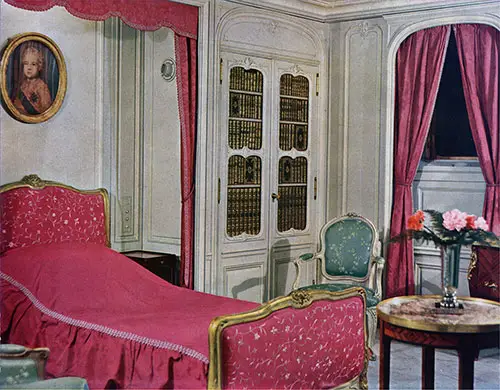
The Bedroom of “JUMIÈGES”, Luxury Apartment (NELSON, decorator). | GGA Image ID # 1271a7df72
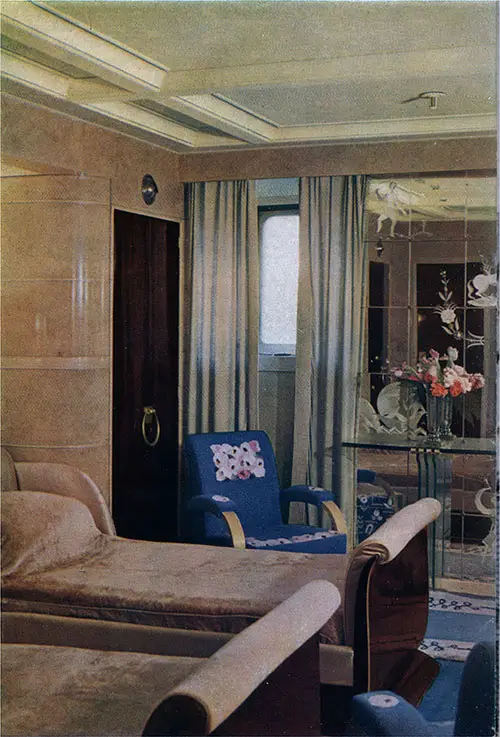
The Bedroom of “DIEPPE” Luxury Apartment. (PASCAUD, decorator). | GGA Image ID # 1271b3e1e2
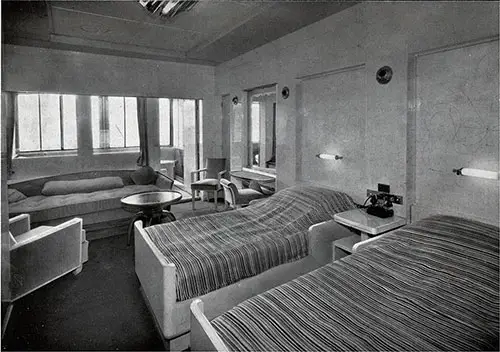
A Cabin-Terrace (PROUX, decorator). | GGA Image ID # 1271fe974e
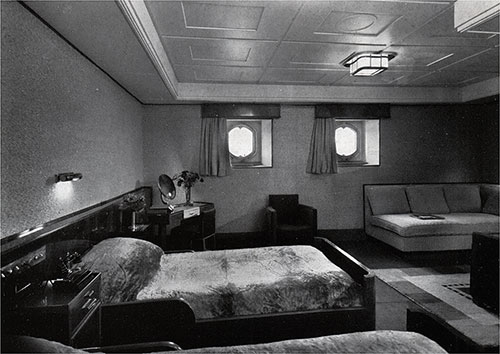
An Exterior Cabin (DOMIN, decorator). | GGA Image ID # 127280e352
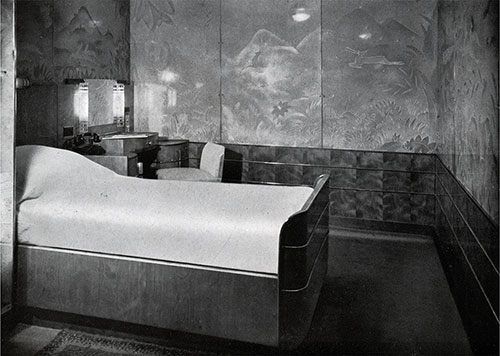
An Interior Cabin (KNIGHT, decorator). | GGA Image ID # 1272e97a9c
Brochure information
- Title: Normandy
- Also known as: The Big Green Brochure
- “Atlantic” Editions
- Pages: 72 and more covers
- Printed: 1937
- Illustrated with photographs by Byron, Arthaud & Schall
- Color photos by D'Arthaud
- Layout and design/Artistic direction by Jan Auvigne
- Dimensions: 27.3 cm x 36 cm (10 3/4" by 14 1/8")
- Printed in France
Recap and Summary: 1937 French Line 'Normandie' Brochure
The 1937 French Line booklet for the SS Normandie is more than a promotional brochure; it is a historical artifact that captures the essence of luxury transatlantic travel. Published in France and extending over 72 pages, the brochure reveals the intricate design, sophisticated amenities, and cultural significance of one of the most iconic ocean liners of the 20th century.
This rare brochure offers a detailed look at the luxurious amenities on board, including sumptuous lounges, state-of-the-art cabins, monumental reception rooms, as well as modern facilities such as the swimming pool and relaxation areas. Richly illustrated with black and white and color photographs, this booklet demonstrates unique artistic and technical know-how.
Historical and Cultural Relevance
For educators, historians, and genealogists, the SS Normandie embodies a key moment in maritime history. It was not only a technological marvel but also a cultural statement of France’s artistic and industrial achievements during the interwar period. The brochure presents insights into the ship's design, technological innovations, and luxurious interiors, reflecting the optimism and opulence of the 1930s.
- Educational Value: Teachers can use the content to illustrate innovations in shipbuilding, engineering, and Art Deco design.
- Historical Insight: Historians and genealogists will find the passenger statistics, crew composition, and decorative elements as a rich resource for understanding transatlantic travel patterns.
- Cultural Heritage: The descriptions of decor, materials, and artists offer a window into the Art Deco movement's influence on commercial architecture.
Key Highlights of the Brochure
The Normandie’s Grandeur:
- The booklet begins with a vivid narrative about the ship's grandeur, emphasizing its spaciousness and innovative design.
- The SS Normandie was described as a 'floating city,' crafted to create the illusion of being in a luxurious hotel rather than aboard a ship.
Engineering Mastery:
- Details on the ship’s propulsion system, including water-tube boilers and electric propulsion.
- The use of bulbous bows, aerodynamic funnels, and modern safety measures highlighted the Normandie's technological superiority.
Interior Design and Art Deco Influence:
- The interior design featured contributions from prominent French artists and designers.
- The Grand Salon's monumental glass panels by Jean Dupas, gilded with precious metals, exemplify the opulence and artistic ambition.
Passenger Experience:
- The descriptions of the Grand Dining Room, Winter Garden, and Theatre illustrate the extraordinary attention to passenger comfort.
- The ship catered to a diverse clientele with well-appointed cabins, luxurious suites, and distinct amenities for children and sports enthusiasts.
The Normandie as a Cultural Icon:
- The ship symbolized France's industrial might and cultural sophistication.
- Insights into the décor of the Chapel, with its modern yet sacred design, and the historical references in the bas-reliefs, provide cultural depth.
Most Interesting Sections
The Grand Dining Room: A room compared to the Hall of Mirrors in Versailles, with 60 tons of glass elements and a ceiling lit with 135,000 candles.
Art Deco Masterpieces: The smoking room's lacquer panels by Jean Dunand and the Grand Salon’s glass panels by Jean Dupas stand out as extraordinary examples of Art Deco craftsmanship.
Innovative Design Features: The concealed mooring equipment and aerodynamic chimney design reflected pioneering advancements in shipbuilding.
Conclusion
The 1937 French Line brochure for the SS Normandie offers more than a glimpse into a magnificent ocean liner; it serves as a comprehensive guide to a bygone era of ocean travel. Its detailed descriptions, historical context, and architectural innovations make it an invaluable resource for various audiences. The ship's fusion of artistic ambition and engineering excellence is captured meticulously, making the Normandie not just a vessel but a testament to France’s maritime heritage.
This document remains a rich educational resource, providing insights into 1930s transatlantic travel, maritime engineering, and the cultural ethos of pre-war Europe.
